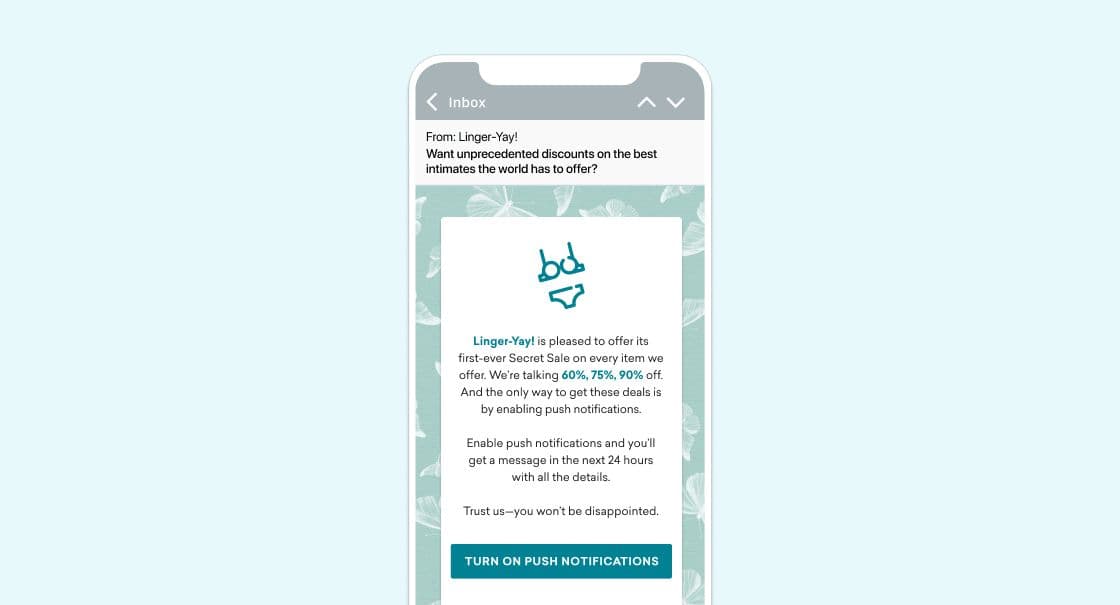What is Repermissioning?
Published on May 14, 2020/Last edited on May 14, 2020/7 min read


Team Braze
Once a consumer says no to email, it’s game over! Right?
After all, your customers aren’t just passive recipients that marketers can hit up endlessly with messages—they’re active participants in the relationship you’re looking to build between your brand and its audience. And it’s natural that if they’re being served up a brand experience that doesn’t speak to them, they might well rescind your authorization to send them emails, push notifications, or other messages (or even uninstall your app altogether).
So the traditional wisdom in digital marketing, especially in our post-GDPR world, is that once someone unsubscribes from your email list or opts out of the push notifications you send, that’s the end of the line when it comes to messaging. And, truthfully, a lot of time that’s the case. But if you’ve adjusted your marketing strategy to make it more relevant, meaningful, and valuable to the people you’re messaging, it just might be worthwhile to let them know and see if they’ll give you another chance.
These messages are known as repermissioning campaigns and with the right approach, they can persuade customers who said no to additional messages in a particular channel to reconsider and grant permission to send again. But this approach can be tricky, so let’s walk through the ins-and-outs of repermissioning campaigns and what it takes to create successful ones.
What Are Permissions?
In essence, “permissions” are requests that an app, website, or other digital platform makes of its users. That could be requests to access customer data, send messages, or allow the platform to take actions that it otherwise wouldn’t be able to.
When a consumer joins your email list, opts in for push notifications, or shares their location data with your brand, they’re granting permissions. And these permissions are conditional—if you don’t use the authorization they’ve granted in ways they expect and appreciate, a lot of users will take them right back.
Why Do Customers Choose to Grant or Rescind Permissions?
As a rule, customers grant permissions when you explain why you need those permissions and how saying yes will help them get what they need and want from your brand. This process, known as “priming,” is all about clearly communicating value and then living up to your promises.
When customers are disappointed in the experience they receive after granting permissions, the risk that they rescind those permissions goes up. Some consumers are more patient (or tolerant) than others, but if you aren’t justifying the permissions you’ve been given with the experiences you’re serving up to them, you’re asking to have your authorization taken away. That’s especially true for messaging channels, where many users will likely have had previous bad experiences where they granted messaging permissions and came to regret it—either because they didn’t get the value they expected, or because giving the permissions caused bad messaging experiences.
(Relatedly, remember that it doesn’t have to be opted in or opted out; many brands give users the option to “opt down” by using a preference center to allow them to set their preferred messaging cadence and message topics.)
What Is a Repermissioning Campaign?
At its core, a repermissioning campaign is messaging outreach that your brand sends to customers who have rescinded (or refused to grant) permissions that your company has requested, with the goal of nudging them to change their minds.

Tips on Sending an Effective Repermissioning Campaign
Every brand’s repermissioning approach will be a little different, in part because repermissioning is really about selling a skeptical customer on the value that your brand can provide them. That value won’t be the same from company to company, and you can’t just take what worked for another brand and use it successfully. That said, here are four high-level best practices that can do a lot to help you put your best foot forward:
1. Target the right people
Your re-permission campaign isn’t going to get far if you can’t identify which members of your audience have refused or rescinded permissions. Making sure that you’re on top of your data collection will allow you to accurately target the customers you’re looking to reach, without bothering people who have already agreed to provide the authorization you requested.
2. Estimate the segment’s awareness
When you run a repermissioning campaign, you’re not starting from scratch. The segment you target has some level of relationship with your brand. If you can assess how much understanding the recipients of your repermissioning campaigns have with your brand and its value proposition (for instance, examining this group’s median average session count or whether the average member of the segment has made a purchase), you can adjust the copy and creative you use to make the most effective case for them to opt back in. If you can’t, it may make sense to subdivide your audience for these campaigns into smaller, more nuanced segments, allowing you to target them with more focused, relevant content highlighting the value of re-granting permissions.
3. Balance offer cost with customer lifetime value
Discounts are understandably a popular choice for repermissioning campaigns, since they make it easy to highlight the value that recipients can see by granting permissions again. But when you’re using discounts in repermissioning, it’s important to be thoughtful about how steep a discount to offer, in order to maximize the effectiveness of the incentive and to ensure that it’s not just a band-aid. After all, while customers will likely love 50% off, they’re also looking to see whether there’s more reason to come back than just a one-time discount. In some cases, the customers you’re looking to persuade will be unlikely to spend enough money going forward to make up for the cost of the savings you’re passing along, meaning that it may be better to let them go instead of spending out the nose to win them back.
4. Optimize the offer to align with the channel
You can’t send a repermission campaign if you don’t have any way to reach the customers you’re trying to persuade. Someone who has opted out of push obviously can’t be reached using that channel; the same goes for someone who has unsubscribed from your email list.
That means that re-permission campaigns for messaging permissions often require your brand to have cross-channel messaging capabilities. While a single channel can suffice for a re-permission campaign targeting mobile systems permissions (for instance, location data access), users respond best to different outreach channels and making use of multiple channels in your messaging can have a major positive impact on its effectiveness.
Whatever channel you end up choosing, it’s important to ensure that you’re using it to speak to recipients in ways that will resonate with them. That means personalizing the content of the messages you send and making sure that their format can support your pitch effectively—after all, every channel serves a different marketing need. (For a deeper dive into creating the right message on the right channel, check out our Channel Messaging Guide.)
Anything Else?
A repermissioning campaign generally won’t work if it’s just an isolated campaign—people opt out of push and unsubscribe from emails for a reason, and if you aren’t going to offer them a relevant, valuable brand experience through your messaging, you’re not going to hold onto these customers over the long-haul. To use repermissioning effectively, you need to put your customer experience first and lay out why their experience will be better this time around and the value that you can really provide
To get it right, it’s important to take into account the specific context, activity, and relationship of each customer to your brand. Learn how to better understand and serve your audience’s needs with relevant, meaningful communications using the Braze Brand Humanity Study.
Related Tags
Be Absolutely Engaging.™
Sign up for regular updates from Braze.
Related Content
View the Blog
How behavioral marketing turns data into personalized experiences

Team Braze

The new inbox reality: How iOS changes are reshaping email marketing

Aparna Prasad

Experience optimization: Turning data insights into better journeys
